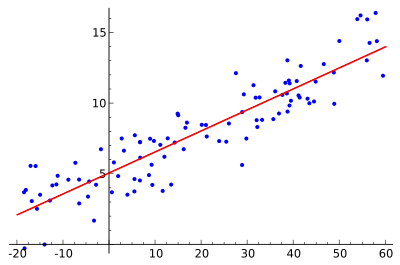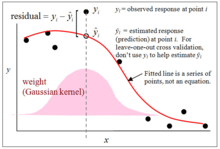Nonparametric regression
Nonparametric regression is a category of regression analysis in which the predictor does not take a predetermined form but is constructed according to information derived from the data. Nonparametric regression requires larger sample sizes than regression based on parametric models because the data must supply the model structure as well as the model estimates.
| Part of a series on |
| Regression analysis |
|---|
 |
| Models |
| Estimation |
| Background |
|
Gaussian process regression or Kriging
In Gaussian process regression, also known as Kriging, a Gaussian prior is assumed for the regression curve. The errors are assumed to have a multivariate normal distribution and the regression curve is estimated by its posterior mode. The Gaussian prior may depend on unknown hyperparameters, which are usually estimated via empirical Bayes. The hyperparameters typically specify a prior covariance kernel. In case the kernel should also be inferred nonparametrically from the data, the critical filter can be used.
Smoothing splines have an interpretation as the posterior mode of a Gaussian process regression.
Kernel regression

Kernel regression estimates the continuous dependent variable from a limited set of data points by convolving the data points' locations with a kernel function—approximately speaking, the kernel function specifies how to "blur" the influence of the data points so that their values can be used to predict the value for nearby locations.
Regression trees
Decision tree learning algorithms can be applied to learn to predict a dependent variable from data.[1] Although the original Classification And Regression Tree (CART) formulation applied only to predicting univariate data, the framework can be used to predict multivariate data, including time series.[2]
See also
- Lasso (statistics)
- Local regression
- Non-parametric statistics
- Semiparametric regression
- Isotonic regression
- Multivariate adaptive regression splines
References
- Breiman, Leo; Friedman, J. H.; Olshen, R. A.; Stone, C. J. (1984). Classification and regression trees. Monterey, CA: Wadsworth & Brooks/Cole Advanced Books & Software. ISBN 978-0-412-04841-8.
- Segal, M.R. (1992). "Tree-structured methods for longitudinal data". Journal of the American Statistical Association. American Statistical Association, Taylor & Francis. 87 (418): 407–418. doi:10.2307/2290271. JSTOR 2290271.
Further reading
- Bowman, A. W.; Azzalini, A. (1997). Applied Smoothing Techniques for Data Analysis. Oxford: Clarendon Press. ISBN 0-19-852396-3.
- Fan, J.; Gijbels, I. (1996). Local Polynomial Modelling and its Applications. Boca Raton: Chapman and Hall. ISBN 0-412-98321-4.
- Henderson, D. J.; Parmeter, C. F. (2015). Applied Nonparametric Econometrics. New York: Cambridge University Press. ISBN 978-1-107-01025-3.
- Li, Q.; Racine, J. (2007). Nonparametric Econometrics: Theory and Practice. Princeton: Princeton University Press. ISBN 978-0-691-12161-1.
- Pagan, A.; Ullah, A. (1999). Nonparametric Econometrics. New York: Cambridge University Press. ISBN 0-521-35564-8.
External links
| Wikimedia Commons has media related to Nonparametric regression. |
- HyperNiche, software for nonparametric multiplicative regression.
- Scale-adaptive nonparametric regression (with Matlab software).